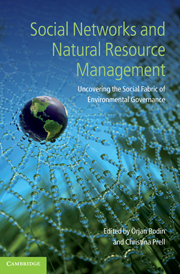 Social Networks and Natural Resource Management
Social Networks and Natural Resource Management Book contents
- Frontmatter
- Contents
- Contributors
- Foreword
- Part I Introduction
- Part II Case studies
- 4 Barriers and opportunities in transforming to sustainable governance: the role of key individuals
- 5 Social network analysis for stakeholder selection and the links to social learning and adaptive co-management
- 6 Who and how: engaging well-connected fishers in social networks to improve fisheries management and conservation
- 7 The effects of social network ties on the public’s satisfaction with forest management in British Columbia, Canada
- 8 Social network models for natural resource use and extraction
- 9 Friends or neighbors? Subgroup heterogeneity and the importance of bonding and bridging ties in natural resource governance
- 10 The role of individual attributes in the practice of information sharing among fishers from Loreto, BCS, Mexico
- 11 Transformative collective action: a network approach to transformative change in ecosystem-based management
- 12 Social networks, joint image building, and adaptability: the case of local fishery management
- 13 Agrarian communication networks: consequences for agroforestry
- Part III Summary and outlook
- Index
- References
8 - Social network models for natural resource use and extraction
from Part II - Case studies
Published online by Cambridge University Press: 05 June 2012
- Frontmatter
- Contents
- Contributors
- Foreword
- Part I Introduction
- Part II Case studies
- 4 Barriers and opportunities in transforming to sustainable governance: the role of key individuals
- 5 Social network analysis for stakeholder selection and the links to social learning and adaptive co-management
- 6 Who and how: engaging well-connected fishers in social networks to improve fisheries management and conservation
- 7 The effects of social network ties on the public’s satisfaction with forest management in British Columbia, Canada
- 8 Social network models for natural resource use and extraction
- 9 Friends or neighbors? Subgroup heterogeneity and the importance of bonding and bridging ties in natural resource governance
- 10 The role of individual attributes in the practice of information sharing among fishers from Loreto, BCS, Mexico
- 11 Transformative collective action: a network approach to transformative change in ecosystem-based management
- 12 Social networks, joint image building, and adaptability: the case of local fishery management
- 13 Agrarian communication networks: consequences for agroforestry
- Part III Summary and outlook
- Index
- References
Summary
Introduction: orientation to network analysis for natural resource usage
The analysis of social networks has tremendous capacity to inform social science and policy about how people extract natural resources (e.g. Prell et al., 2009). Attention to social networks frees us from the typical assumptions that individuals act independently or are independent conditional on membership in common organizations (Frank, 1998). Instead attention to social networks embraces the relational (Emirbayer, 1997), and, as it does so, provides a potential bridge between different disciplines and modes of research.
- Type
- Chapter
- Information
- Social Networks and Natural Resource ManagementUncovering the Social Fabric of Environmental Governance, pp. 180 - 205Publisher: Cambridge University PressPrint publication year: 2011
References
- 11
- Cited by


